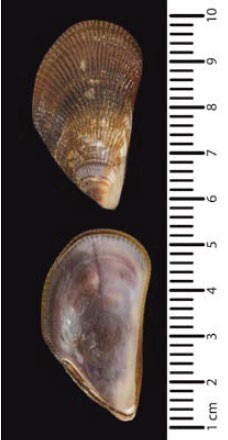Black striped false mussel (Mytilopsis sallei) grows quickly and competes with native species for food and space. It can affect the productivity of commercial fisheries and aquaculture.
What to look for
Features:
- unequal sized shells (one side overlaps the other)
- smooth, small and easily crushed
- forms dense clusters
- sometimes zig-zagged or striped
- up to 2.5cm long.
Where to look
Look in or around:
- hulls
- infrastructure
- pylons
Likely habitats include:
- shallow waters, up to a few metres deep
- subtropical to tropical waters
Similar native species
These native species look similar to Black striped false mussel. They do not need to be reported.
Brachidontes maritimus
Features:
- thicker, black–brown shell
- strong ribs along the length of the shell (not radially striped)
- up to 4.5cm long.
Habitat:
- hard substrates
- rocky shores.
Known location is northern Australia.
Goose barnacle (Lepas species)
Features:
- white shell
- rubbery brown stalk.
Habitat:
- attaches to floating objects.
Known to occur in all tropical and water temperate waters.
Report it
See something unusual? Report it. Even if you’re not sure.
If you see something you think is a pest:
- note the exact location (screenshot your map app or enable photo geotagging on your phone)
- take a photo (use something for size reference, like a coin or note)
- contact your state or territory authority.
Stop the spread of marine pests
Start with these simple steps:
- Inspect and clean your boat or yacht. Make sure you check hard to reach areas.
- Treat the hull of your boat or yacht regularly.
- Clean and dry your fishing and diving gear after every use.
How you can stop the spread of marine pests.
Your location
The map shows known pests and pests to look for around Australia.





